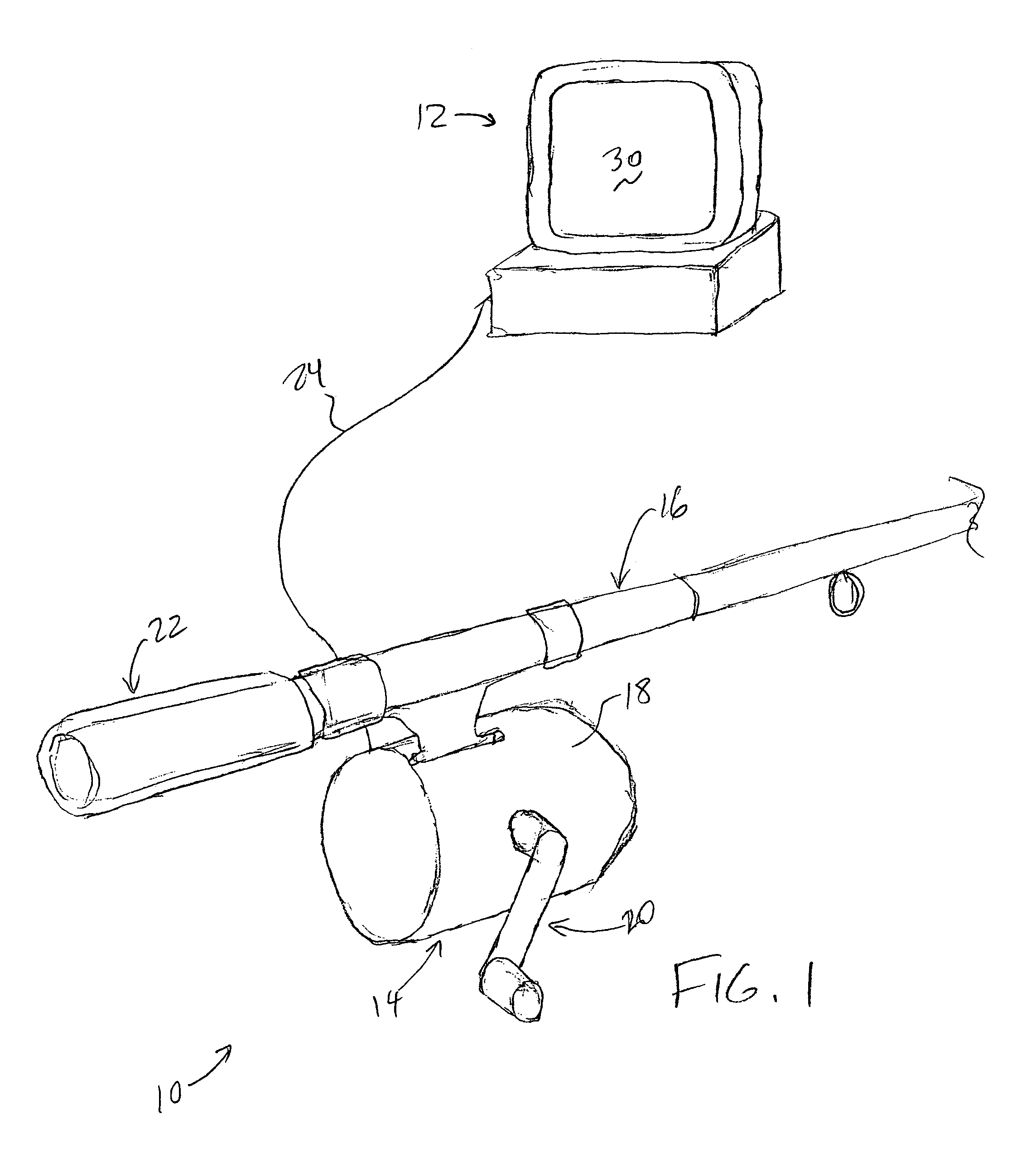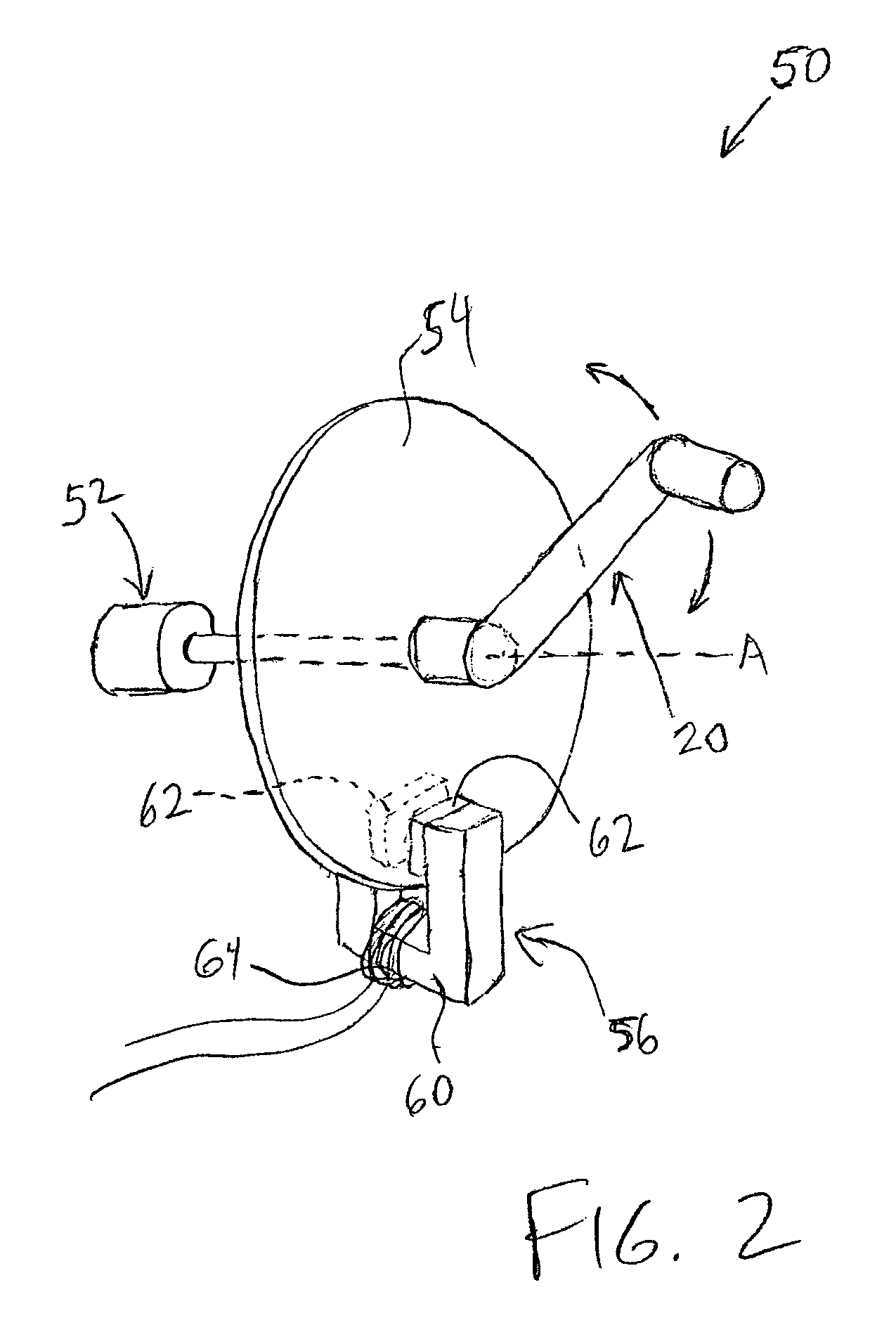Force feedback devices using fluid braking
a technology of force feedback and feedback device, which is applied in the field of computer device interface, can solve the problems of high cost, large size and weight, and high cost of passive actuator, and achieve the effects of low cost, high output force and maintaining inherent safety
- Summary
- Abstract
- Description
- Claims
- Application Information
AI Technical Summary
Benefits of technology
Problems solved by technology
Method used
Image
Examples
first embodiment
[0020]FIG. 1 is a perspective view of a force feedback interface device 10 of the present invention, in which a fishing game or simulator is implemented. The device 10 is used for interfacing a user with a computer generated environment implemented by a host computer 12.
[0021]Interface device 10 of the described embodiment is in the form of a fishing rod and reel, of similar shape and size to rods and reels used by fisherman, and includes a reel unit 14 and a rod 16. Reel unit 14 of the interface device 10 can be shaped and sized similarly to a reel used on a standard fishing rod, and includes a reel housing 16 and a reel crank arm 18. Reel housing 16 encloses mechanisms for reading the position of the reel crank 18 and providing haptic feedback on the reel crank 18, as described in greater detail below with respect to FIG. 2. Reel crank arm 18 can be rotated by the user in a rotary degree of freedom similar to a crank arm on a standard fishing reel. A sensor signal is preferably pr...
second embodiment
[0041]FIG. 3 is a perspective view of the present invention. Interface device 10′ is a bicycle simulation device that can be used to simulate riding a bicycle, similar to a bicycle exercise machine or the like. A stationary frame 80 rests on a ground surface and provides a structure of a similar height to a bicycle. A seat 82 is coupled to the frame on which the user sits during operation of the device 10′. Handlebars 84 are rotatably coupled to the frame 80 and are grasped by the user's hands during operation of the device and may be rotated to simulate turning the bicycle. Pedal assembly 86 is rotatably coupled to the frame 80 and supports the user's feet during operation. The pedal assembly 86 includes pedal arms 88 and pedals 90, each pedal 90 rotatably coupled to an associated pedal arm 88. The pedal arms 88 are preferably rigidly coupled to each other, where the second pedal arm is oriented 180 degrees from the first pedal arm. The pedal arms 88 can be rotated in a rotary degr...
embodiment 120
[0055]FIG. 5 is a perspective view of another embodiment 120 of an interface device of the present invention including a magnetorheological brake. Embodiment 120 includes a two-degree of freedom cylindrical controller that can be used to provide input control signals to a computer or other electronic device, e.g. to control the movement of a cursor in a graphical user interface displayed by a host computer 12. A cylinder 122 may be rotated about an axis C and translated parallel to the axis C by the user. The outer surface of the cylinder 122 can include annular and longitudinal grooves 124 which intersect each other. Two pinions 126 positioned at right angles with respect to each other mesh with the grooves 124 so that when the cylinder is rotated, one pinion 126a rotates, and when the cylinder is translated, the other pinion 126b rotates. A metal disk 128 is connected to each pinion 126 by a rotating shaft 130, and an magnetorheological brake 132 as described in detail in FIG. 2 p...
PUM
 Login to View More
Login to View More Abstract
Description
Claims
Application Information
 Login to View More
Login to View More - R&D
- Intellectual Property
- Life Sciences
- Materials
- Tech Scout
- Unparalleled Data Quality
- Higher Quality Content
- 60% Fewer Hallucinations
Browse by: Latest US Patents, China's latest patents, Technical Efficacy Thesaurus, Application Domain, Technology Topic, Popular Technical Reports.
© 2025 PatSnap. All rights reserved.Legal|Privacy policy|Modern Slavery Act Transparency Statement|Sitemap|About US| Contact US: help@patsnap.com



